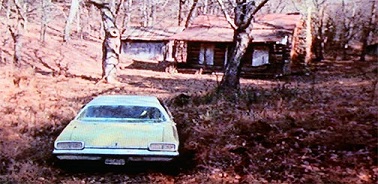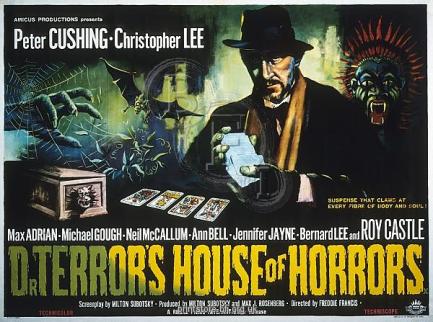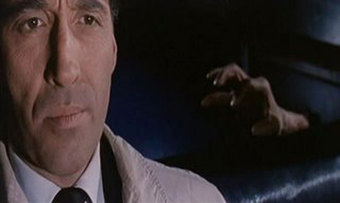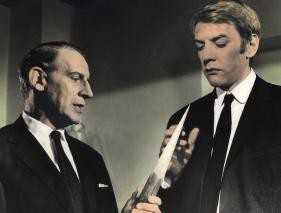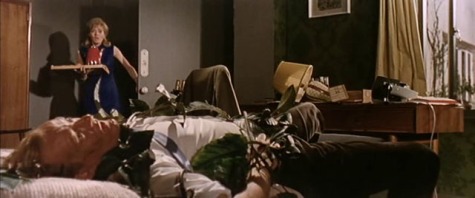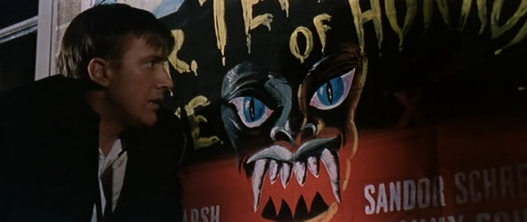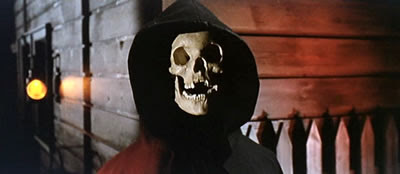Possible Spoilers Ahead.
Amicus Productions was set up in the 1960’s by Milton Subotsky and Max J Rosenberg. Motivated by both a love of the horror genre and easy profit that could be made from producing such fare very cheaply, the studio nonetheless attracted big acting stars at the time to appear in them. Often mistaken for films made by the at the time all conquering Hammer Studios (a slight surely felt strongly by Subotsky, who hated the more famous studio after Hammer rejected one of his scripts in the 1950’s), Amicus nonetheless carved out their own niche of the horror market with their anthology series of films, of which they made seven during the 1960’s and 70’s. The first of which was 1965’s Dr Terror’s House of Horrors, a highly lurid, but very entertaining affair that set the precedent for all of Amicus’ portmanteau films that would follow.
Six strangers board a train. The strangest of these strangers is the mysterious Dr Schrek (Peter Cushing), who declared that by the use of his tarot cards (or his, ‘House of Horrors’ as he refers to them) he can reveal the possible fate of these men, and whether there is anything they can do to avoid this destiny. In turns curious, amused or outright dismissive of Schrek’s claims, all five men are tempted into tapping the pack of cards three times, and listen avidly as Dr Schrek tells them of the horror that is due to enter their lives…
In Werewolf architect Jim Dawson (Neil McCallum) receives a request from the woman who bought his former home to visit her there to discuss alterations she wishes to make to the property. At first Mrs Biddulph (Ursula Howells) is a friendly and welcoming host but a sense of unease soon comes over Jim, especially when he finds a coffin in a sealed room in the cellar of the house and the house maid disappears. The title of this segment gives the game away pretty much by virtue of existing so it shouldn’t be a surprise to anyone that Dawson’s fate involves one of these hairy lycanthropes.
The next tale Creeping Vine, features Alan Freeman as Bill Rogers, who returns home from a holiday with his family only to discover an odd looking plant has taken up residence outside his house. When attempts to remove it fail he goes to the Ministry of Defence who install two scientists (including Bernard Lee, better known as ‘M’ in the James Bond films) in his house in an attempt to discover more about the plant. It soon becomes apparent that the plant is self-aware and murderous, and growing at an alarming rate…
In Voodoo jazz musician Biff Bailey (Roy Castle from Record Breakers fact fans) travels to the West Indies with his band where he watches the locals participate in some sort of voodoo ritual. Despite all sorts of warnings about Voodoo God revenge, he steals the tune and takes it back to London with him, naturally this doesn’t go well for him.
In Disembodied Hand, when Franklyn Marsh, a sneering and pompous art critic (Christopher Lee) is the butt of a prank played on him by an artist Eric Landor (Michael Gough), who he has eviscerated in print once too often, he gets his revenge by running the artist over. After the accident Landor loses his hand and kills himself in despair. At first racked by guilt, Marsh is soon racked by fear as the disembodied hand of the dead artist starts tormenting him. Despite his best efforts to dispose of it, it is very tenacious and determined to teach Marsh the meaning of the phrase ‘cruel irony’ when it causes Marsh to crash his car and lose his eyesight.
The final story is Vampire, in which newly wed Dr. Bob Carroll (a very young Donald Sutherland) returns to America with his new wife Nicolle (Jennifer Jayne) only to discover there is a vampire on the loose, and it appears his wife is the most likely suspect. He confides in his colleague Dr. Blake (Max Adrian) who advises him to stake her through the heart. Upon doing this he is promptly arrested for murder, while Dr Blake denies any involvement. Dr Blake is of the mind that there isn’t enough room for two doctors in this town, let alone vampires.
Once all their fates have been read, they all demand that Schrek reveal the card that foretells if they can survive these horrors. In each case the card drawn is Death. Schrek informs them that, essentially, a ‘mundane’ death is the only way to avoid a more supernatural death. With that the train arrives at its destination; Bradley. Or does it?
Dr Terror’s House of Horrors won’t be scaring any hardened modern audiences rigid any time soon but it does possess a wonderful atmosphere, ably assisted by the actors playing their parts absolutely straight. Christopher Lee and Peter Cushing are, as one would expect, the stars of the show. Lee is on fine form as the sceptic and boorish art critic. He also has the best segment in the film. It is testament to Lee’s skills that you really believed that he was deathly afraid of the vaguely ridiculous looking rubber hand that was assaulting him. Cushing and Lee always sparred off each other wonderfully and the scenes with the two of them clashing on the train are also nicely energetic. Cushing brings an unsettling malevolence to Schrek (a couple of accent slips aside. Sterling eyebrow work though), made more unnerving by the gentleness of his candour. While Disembodied Hand is the stand out segment of the film, Werewolf and Vampire are also worth a watch. Werewolf suffers from trying to cram too much back-story into too short a time-frame, in which the last few minutes a garbled rush of exposition and twists. Ursula Howells is good value as seemingly perfect host Mrs Biddulph. If this story was twenty minutes longer it could have made a good episode of the Hammer House of Horror television programme. Vampire makes better use of its limited run-time, with a snappy pace that doesn’t get bogged down in any frivolous details about family vengeance and curses. Donald Sutherland, in one of his first film roles, impresses, despite the paper thinness (and extreme gullibility) of his character.
In anthology films there always tends to be one ‘comedic’ story, Dr Terror’s House of Horrors seems to have two. Both Creeping Vine and Voodoo immeasurably silly, although Creeping Vine does pip Voodoo as most eye-roll inducing. It’s as if someone read Day of the Triffids in Hungarian and then tried to replicate it with a budget of £6.50. Lead actor in this segment, Allan Freeman, was not actually an actor but a radio DJ. And it does show, sadly. It also has an off puttingly abrupt ending. It’s hard work to make killer plants scary and not laughable; this trick is not pulled off here. Voodoo has a scarier concept, but poor execution. The music is funky, but overtakes from the actual story. There is a nice instance of fourth wall breaking when Biff Bailey is running from invisible voodoo forces through the streets of London and halts in front of a film poster advertising Dr Terror’s House of Horrors but that was the highlight of the story for me. Even these two stories have a certain hokey charm about them, but they are definitely the weakest in the film.
The directorial debut of noted cinematographer Freddie Francis is tight and the action rattles along at a fair old pace (occasionally at the expense of the stories). He makes the best use possible of the limited budget by investing plenty of enthusiasm in the stories, excellent use of visuals and elicits fine performances from the majority of the cast.
Dr Terror’s House of Horrors is a very enjoyable, entertaining ride, with a large side-order of archness and camp. Which is just the sort of thing one looks for when revisiting these sorts of films. It kick-started the Amicus business model and while many may argue they did it better with later films once they had refined the formula somewhat, Dr Terror’s House of Horrors still holds enough charm to be re-watched many times over, long after you know the twists.
